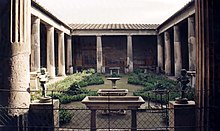Terminus ante quem

A terminus ante quem ( Latin for 'point in time before') - abbreviated taq or TAQ - is used in historical studies to date a source . The terminus ante quem specifies the point in time before which the desired event must have happened. A very well-known example from archeology are the cities on Vesuvius , such as Pompeii , which were buried when the volcano erupted on August 24, 79 AD. All buildings and finds from these places must therefore be older.
Terminus post quem
The term terminus post quem (Latin for 'point in time after') - abbreviated tpq or TPQ - is used with a similar meaning . With the help of the tpq , an event can be narrowed down in relation to an earlier point in time. For example, a coin recovered from an archaeological find (or, in the case of several coins, the so-called final coin that was last minted ) provides the tpq for the complex of finds, since this cannot have got into the earth before the money was minted (cf. coin dating ). In the case of works that can be forged, such as documents, a term post quem is in principle safer than a term ante quem because of the impossibility of knowing future events . A term post quem can also be used deliberately - for example, the terrorists of the Red Army Faction repeatedly photographed their kidnapped victims with the latest daily newspapers in order to prove that the hostage was still alive on the day the respective newspaper was published.
Terminus a quo and terminus ad quem
For event dates that can be narrowed down within a certain period of time, the terms terminus a quo (Latin for `` point in time from '') are preferably used for the earliest possible and terminus ad quem (Latin for `` point in time up to '') for the latest possible point in time . In the practical use of the definition or in certain individual cases, however, both terms do not necessarily have to be specified.